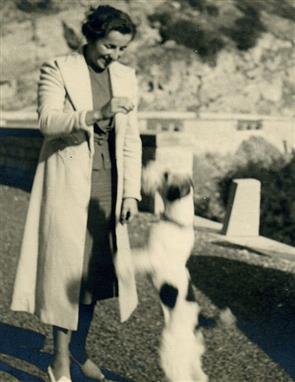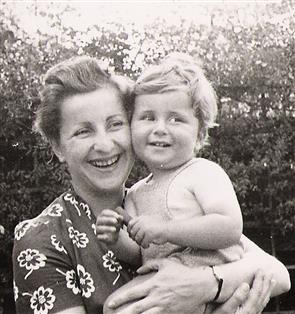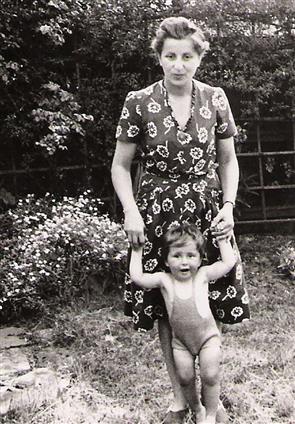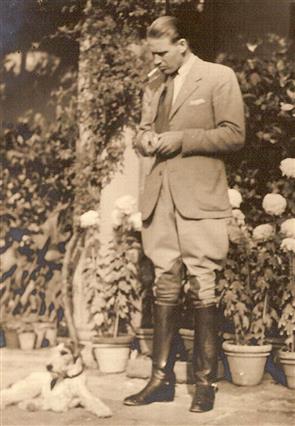


Alexandra de Hadeln - Balaceano (1911-1977)
Draft for a biographie (2)
1939
Worried by the repercussions of Mussolini’s colonial wars, the couple leaves Italy for Britain at the end of August 1938, first on the eve of the Munich agreement, then a second time end of August 1939. In September Harry enlists as voluntary in the British army and enters the military academy at Sandhurst, graduating with the grade of captain. In 1937 Harry had changed his surname “von Hadeln-Hudson” into “von Hadeln”; at the end of 1939 from “von Hadeln” to “de Hadeln”. Shortly before Mussolini declares war, Alexandra sets off on her own by car during the “phoney war” to Florence to try and secure the family possessions. Soon after their villa is confiscated as “enemy property”.
1940
The German army invades France. Alexandra soon loses all contact with her mother and sister who stay in Aix-les-Bains, then in Vichy.
She tries to contact them in vain through the International Red Cross. While her husband is incorporated in the 8th Army in North Africa and later Italy, and will only return once to Britain during the war, Alexandra moves around; London, Oxford, Twekesbury and Upton. She continues her sculpting career and makes a series of drawings and oils, inspired by the horrors of war. She also participates in a travelling exhibition of British artists across the country.
As a French speaker she avidly follows the news of occupied France and subscribes to the magazine “La France Libre”. She befriends the Romanian cultural attaché, Ciotori, paints his portrait and sculpts a bust.
Following an earthquake in Romania in the same year, the family property in Scaeni is completely destroyed.

1940, 21 December
Birth in Exeter (Devon), where Harry’s regiment was stationed, of Moritz, the couple’s second son. The hospital is bombed hardly a week later by a German aeroplane. Moritz is baptised orthodox in North Ireland – it is said in a bathtub - by the orthodox priest of a captured Greek ship. Moritz is subsequently entrusted to a nanny for long periods of time to keep him away from the bombings and to allow Alexandra to pursue her career.
1942 31 March
Alexandra is to be elected member of the “Royal Academy of British sculptors”. Her candidature having been proposed by the sculptor Charles Wheeler (1892-1974, known for his sculpture on Trafalgar Square fountain) and Margaret Wrightson. However, as she can’t be traced after her departure from Britain in 1945, her participation is later suspended and never renewed.

1944-1945
On 15 September 1944, her sister Yvonne gives birth to a son, Emmanuel Balaceano, whom Alexandra won’t meet until having found her sister and mother in Paris after the war. Alexandra volunteers as an ambulance driver in the British Red Cross, secretly hoping to be sent to France to see her family. Instead, her unit is sent to Belgium, and then intended for the liberation of concentration camps but in the beginning of 1945 she resigns and returns to London to join her recently de-mobbed husband. The family travel to Paris, Macon, Aix-les-Bains on the way to Florence. Alexandra sketches and paints watercolours on the way, except, curiously enough, in Aix-les-Bains.
In the collection of artists writings “De la Palette à l’Ecritoire” (ed. Correa) published in 1946 by Andre Lhote, which she reads regularly she underlined among other items, the accusatory text by Maurice de Vlaminck on Picasso: “Picasso is guilty of having dragged French painting to a deadly standstill, into an indescribable confusion. Picasso is impotence personified”. Alexandra was never attracted by cubism, even if two sketches of a group of horses show she experimented briefly with it. She chose an artistic course outside any “school”, thus barely following in the steps of her teacher André Lhote.
1945-1946
After the war was over, Harry had an offer to continue his military career which he refused. He broke off all contact with Germany except for a regular correspondence with the Berlin sculptress Renée Sintenis (1888-1965), for whom he had posed in the past.
After the war financial difficulties accumulated. Their villa via del Pergolino, Carreggi (Florence) had to be sold, the lira was devalued. The family briefly stayed at via dei Fossi, then as sub-tenants in via Santo Spirito, which later was to become their apartment, with a view from all windows on the Arno, between the destroyed bridges of Carraia and Santa Trinita.
Under these conditions it was impossible to continue a career in sculpting. So Alexandra threw herself heart and soul into drawing and painting. The family renewed contacts with pre war acquaintances, the Ferragamos, Guccis, De Faveris, Viganos and many others; entrepreneurial families whose names, decades later, would be known worldwide. Even with only 50 lire in her pocket, Alexandra always kept a remarkable dignity, hiding her difficulties from her surroundings and friends, an attitude she kept all her life, which commands respect.
Times called for action. In the spring of 1946 the couple embarked on the “Queen Elizabeth” from Cherbourg to New York, with suitcases stuffed with Florentine handicraft (pottery, silver, leather trinkets and a few prints bought from the publisher Albizzi, on the Cathedral square piazza del Duomo). While Moritz was boarded out in Quesce, Florence, the couple crisscrossed the US for nearly 3 months, selling everything they brought with them. It was a first success, but only the prints –flowers by Laudon- were reordered, which indicated a line to be developed. In 1948 they even allowed themselves a short break in San Francisco, visited the Fisherman’s wharf and attended a jazz concert. As previously in New York, this resulted in several watercolours and paintings.





1947
Alexandra exhibits her watercolours and paintings for the first time in Paris, at the Jeanne Castel Gallery. Meanwhile, the couple start as print publishers, even creating a company in Paris, “Glamor ltd.”, registered with the engraver André Nourisson who at the time worked for the state (banknotes and stamps) as well as famous artists, in particular Buffet and Salvador Dali. At the end of the sixties, the company counted no less than approx. 400 copperplates of classical reproductions (Watteau, Boucher, Piranese, Poilly, etc) and a few modern artists. This production largely aimed towards decoration, was meant for wholesale to interior decorators while there was a true building boom in hotels and offices.
1949
The de Hadeln sail to the US every January, until the beginning of the sixties. In the beginning Alexandra stayed in New York looking after local clients, while Harry crisscrossed the country by Greyhound bus, loaded with a heavy suitcase full of samples. During one of these trips she had acute appendicitis and had to be operated on board in mid Atlantic. At the same time their son fell seriously ill in Florence and had to be hospitalized several times. Medical bills piled up, but business was doing well. At the end of January 1949, Alexandra organized her first exhibition on American soil at the van Diemen Lilienfeld Gallery where she showed a wide choice of watercolours and portraits from Florence as well as some painted the previous year in New York and San Francisco.
page 2 of 4






